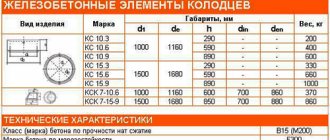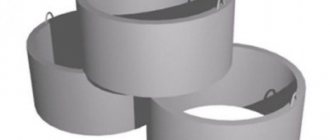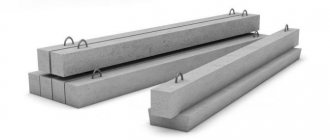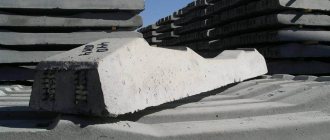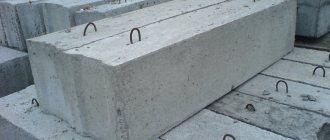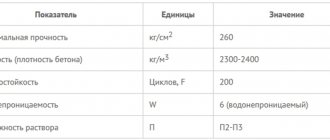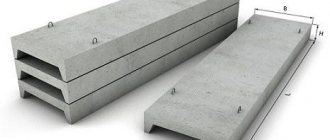The installation of a sewerage system and a well is a prerequisite in private and multi-storey buildings. Such structures are subject to certain requirements, so they must fully comply with sanitary and hygienic standards. In addition, when installing a well treatment system for a country house, any person expects that the structure will last for decades, serving faithfully.
Therefore, the optimal solution when performing such work would be to install a concrete ring. This product is made of strong and durable material that can last almost forever, provided that the ring is correctly selected and the installation is carried out in compliance with all requirements. Therefore, it makes sense to consider the features of concrete rings, understand the size range and installation methods.
What types of rings are there? Types and purpose
Well rings are round reinforced concrete structures used for arranging utility lines buried below ground level. Depending on the structure being constructed, the following types of rings are used:
- Sewage and water intake.
- Products for laying underground cable electrical networks.
- Collectors.
- Gas pipelines and water intakes.
In addition, there are the following varieties on the market:
- Rings with flat and locking ends.
- Repair.
- Additional ones.
- Supporting.
Regardless of the type and purpose, the products are made of heavy concrete, grade 200-500 , and reinforced.
Application area
The scope of application concerns the arrangement of structures characterized by high tightness. That is why reinforced concrete products are used to construct a septic tank. A septic tank is the same drainage pit, but with the ability to treat wastewater. A septic tank of two or three parts can be installed on one site.
The more well rings you use, the cleaner the water will be when it comes out. In the case of three rings, the septic tank can produce almost pure water at the outlet, which can be used to water the garden.
When using rings as a basis for a septic tank, they must be additionally sealed. To do this, the outer diameter of the hole in the ground is dug out larger, a septic tank is installed, and then the outside is coated with bitumen.
Using reinforced concrete rings for cesspools
Using well rings, today you can equip a pit for a well. This is a recess of up to 2 meters, where equipment can be installed in the future. By default, the well head is located on the base of such a pit. It is recommended to install well equipment in homes, since here it will be less exposed to moisture. This way the pressure switch can work longer without failure.
Reinforced concrete rings are also used for constructing wells. In this case, they can be with a base and a lid. This will keep the water used for drinking and irrigation clean. The diameter is not chosen to be the largest so that the water column meets the customer’s wishes.
Otherwise, reinforced concrete rings are used for the needs of sewer systems, for laying communications underground, and for constructing underground drainage holes. They are able to withstand significant external loads from the soil, and not collapse under the influence of moisture for a long time. By performing the necessary sealing of the joints, you can achieve 100% insulation, which is important when installing cables, pipes and other communication systems inside the rings.
Production technology
Rings for wells are made from hard concrete, which is poured into the formwork. It is necessary to clarify that the reinforcement is first made from steel wire with a diameter of 8-12 mm . Two vertical rods are installed at opposite ends of the structure, which act as lugs for lifting the ring.
The mold is compacted using vibration to prevent the formation of voids. The formwork is removed one day after pouring the concrete. After this, the finished products are stored in open areas. The ring's tempering strength ( 50% of the specified value ) is achieved in approximately 7 days . Full concrete strength is achieved after 28 days .
Practical advice
There are several rules, the implementation of which is considered mandatory. There is no need to invent anything on your own, the technology has been used for many centuries, during which time masters have encountered various situations and, based on their experience, have developed universal recommendations.
- Immediately after dismantling the form, it must be washed and thoroughly cleaned of concrete residues. This should be done not after the work is completely completed, but regularly. The fact is that then the concrete will gain greater strength and will firmly stick to the form. It is very difficult to remove; even strong blows with a sledgehammer do not help. Not to mention that such impacts cause great harm to the form: the walls are deformed, the integrity of welds and other joints is compromised. Uneven walls of the inner ring will make the process of removing them much more difficult.
The mold needs to be cleaned after disassembly. - Lubricate the surfaces of the mold thoroughly, more is better than less. It takes a few minutes to prepare the mold, and the manufacturing process is greatly accelerated. We have already mentioned that the dismantling of the structure is carried out on wet concrete; excessive efforts when removing the form can completely destroy the ring.
- Choose a working place under a canopy, do not expose the form to direct sunlight. The metal gets very hot and quickly transfers heat to the concrete; it does not set due to chemical reactions, but simply dries. As a result, the outer layer crumbles, the thickness of the defect depends on specific conditions.
It is not recommended to make concrete rings outdoors (without a canopy) - If the rings will be mounted at a great distance from the place of manufacture, then it is necessary to insert running brackets for hooks of lifting mechanisms. They are made from wire rod with a diameter of ≈ 6 millimeters. The initial length of the wire is not less than the height of the ring, then it is bent in half, the lower ends are bent again at an angle of 90°. Due to this design, the forces are distributed slightly below the axis of symmetry of the ring, which eliminates the possibility of tipping over during lifting, and a large layer of concrete prevents the hooks from being pulled out.
A well requires up to 10 rings, and with one mold they can be made in about 12 days.
Advantages and disadvantages of reinforced concrete rings
It's no secret that any building material has its strengths and weaknesses. This feature also applies to finished products. Concrete rings seem ideal, but even they are not without some drawbacks.
The undeniable advantages of reinforced concrete rings include the following:
- High quality at an affordable price.
- Wide range of sizes.
- The ability to quickly install a water supply and sewerage system.
- High tightness: tight fit of the seams prevents groundwater from entering the structure.
- Long service life: reinforced concrete is neutral to any environment, so it can last at least 100 years .
- Structural rigidity: wells made of concrete rings can be installed even on unstable soil.
Obvious disadvantages include the following:
- Dimensions and weight: it is impossible to install a concrete ring without the use of construction equipment, which somewhat increases the cost of installation.
- Lack of mobility: it is very difficult to move such a well.
You can see that there are more positive features, which explains the steadily growing popularity of concrete rings.
Reinforcement
Reinforcement of rings is necessary to increase their service life. Reinforced elements are made using the same vibration pressing method, during which they acquire a more dense structure and become stronger.
In addition, such products have increased water resistance, which allows them to be used for constructing septic tanks that prevent water from entering the ground. The same can be said about groundwater: the tight fit of the component parts to each other eliminates the possibility of the formation of large gaps, and groundwater will not flow into the well source.
Marking according to GOST. How to read symbols correctly
Each reinforced concrete ring has a marking that determines the scope of application of the product. The symbols correspond to GOST standards, it looks like this:
- KLK - products intended for the arrangement of drains and urban storm sewers.
- KVG - rings used for installation of gas pipelines and water wells.
- KO is a support ring that forms the foundation of the well.
- KS - wall models installed in limited spaces.
- KFK – drainage systems and collector networks.
In addition, the ring markings also contain numerical designations.
Decryption example:
KS-7-9 . This means a wall ring with a wall thickness of 70 and a height of 900 mm .
Pouring concrete mixture into a mold
When all the preparatory work is completed, they begin to manufacture the well ring.
Work order:
- Preparing the base . A sheet of iron or a wooden shield is laid on a flat surface.
- Form assembly . The blanks are installed (one inside the other), and the parts of the formwork are carefully secured.
- Form reinforcement . A reinforcing frame is lowered between the outer and inner walls of the formwork, fixing its position with wedges.
- Pouring the structure . Thick concrete mortar (W/C = 0.5) is placed in the interannual space in small layers (about 100 mm) and compacted using a steel pin with a diameter of 20 mm. The creamy solution (W/C = 0.7) is immediately poured into the mold to the brim, and then the mixture is compacted with a pin.
- Aligning the rings . After filling the entire form, they begin to level the end of the concrete ring, using a trowel to add mortar where it is missing. The product is covered with polyethylene or thick fabric.
- Removing formwork . Stripping begins after 3-4 days (if the concrete was thick), after 5-7 days (if the solution was liquid), leaving a ring on a metal sheet or wooden panel.
- Maturing of concrete . The reinforced concrete ring is wrapped with packaging film so that the composition ripens evenly over 2-3 weeks, gaining final strength.
It is recommended to wet the product with water every 4-5 days while the concrete is maturing.
The same technology is used to make rings for a cesspool. Detailed information about the classification and methods of manufacturing concrete rings for sewerage can be found in this article.
Standard sizes of reinforced concrete rings
Concrete rings are available in a very diverse range of sizes. Standard product sizes look like this:
- Height: 10-100 cm .
- Wall thickness: 70-120 mm .
- Inner diameter: 70-200 cm .
- Specific gravity: 46-2,300 kg .
Thanks to these standard sizes, choosing rings for arranging an individual water supply system is not difficult.
| Name | Diameter D, mm | Diameter d, mm | Height h, mm | Thickness, mm | Concrete volume, cubic meters | Weight, tons |
| K-10-10 | 1160 | 1000 | 990 | 80 | 0.27 | 0.68 |
| K-10-5 | 1160 | 1000 | 490 | 80 | 0.14 | 0.35 |
| K-12-10 | 1410 | 1250 | 990 | 80 | 0.33 | 0.82 |
| K-12-5 | 1410 | 1250 | 490 | 80 | 0.17 | 0.42 |
| K-15-10 | 1680 | 1500 | 990 | 90 | 0.44 | 1.1 |
| K-15-5 | 1680 | 1500 | 490 | 90 | 0.22 | 0.55 |
| K-20-5 | 2200 | 2000 | 490 | 100 | 0.33 | 0.82 |
| K-7-1.5 | 840 | 700 | 145 | 70 | 0.024 | 0.06 |
| K-7-10 | 840 | 700 | 990 | 70 | 0.17 | 0.42 |
| K-7-5 | 840 | 700 | 495 | 70 | 0.084 | 0.21 |
| KS 7.6 | 840 | 700 | 590 | 70 | 0.3 | 0.25 |
| KS10.18a | 1160 | 1000 | 1790 | 80 | 0.46 | 1.15 |
| KS10.3 | 1160 | 1000 | 290 | 80 | 0.08 | 0.2 |
| KS10.6 | 1160 | 1000 | 590 | 80 | 0.16 | 0.4 |
| KS10.9 | 1160 | 1000 | 890 | 80 | 0.24 | 0.6 |
| KS10.9a | 1160 | 1000 | 890 | 80 | 0.22 | 0.55 |
| KS13.6 | 1410 | 1250 | 590 | 80 | 0.2 | 0.5 |
| KS13.9a | 1410 | 1250 | 890 | 80 | 0.28 | 0.7 |
| KS13.9b | 1410 | 1250 | 890 | 80 | 0.24 | 0.6 |
| KS15.18 | 1680 | 1500 | 1790 | 90 | 0.804 | 2.01 |
| KS15.18a | 1680 | 1500 | 1790 | 90 | 0.75 | 1.88 |
| KS15.18b | 1680 | 1500 | 1790 | 90 | 0.72 | 1.8 |
| KS15.6 | 1680 | 1500 | 590 | 90 | 0.265 | 0.66 |
| KS15.6b | 1680 | 1500 | 590 | 90 | 0.22 | 0.55 |
| KS15.9 | 1680 | 1500 | 890 | 90 | 0.4 | 1 |
| KS15.9a | 1680 | 1500 | 890 | 90 | 0.35 | 0.88 |
| KS15.9b | 1680 | 1500 | 890 | 90 | 0.32 | 0.8 |
| KS20.12a | 2200 | 2000 | 1190 | 100 | 0.67 | 1.68 |
| KS20.12b | 2200 | 2000 | 1190 | 100 | 0.64 | 1.6 |
| KS20.18b | 2200 | 2000 | 1790 | 100 | 1.02 | 2.55 |
| KS20.6 | 2200 | 2000 | 590 | 100 | 0.39 | 0.98 |
| KS20.6b | 2200 | 2000 | 590 | 100 | 0.3 | 0.75 |
| KS20.9 | 2200 | 2000 | 890 | 100 | 0.59 | 1.48 |
| KS20.9b | 2200 | 2000 | 890 | 100 | 0.44 | 1.10 |
| KS25.12a | 2700 | 2500 | 1190 | 100 | 0.87 | 2.18 |
| KS25.12b | 2700 | 2500 | 1190 | 100 | 0.76 | 1.90 |
| KS25.6 | 2700 | 2500 | 590 | 100 | 0.48 | 1.2 |
| KS7.3 | 840 | 700 | 290 | 70 | 0.05 | 0.13 |
| KS7.9 | 840 | 700 | 890 | 70 | 0.15 | 0.38 |
| KTs12.9 | 1410 | 1250 | 290 | 80 | 0.30 | 0.75 |
| KTs25.12 | 2700 | 2500 | 1190 | 100 | 0.97 | 2.42 |
| PK-7S | 870 | 650-670 | 360 | 100-110 | 0.036 | 0.09 |
What else is needed? Additional items
It should be noted that installing rings alone will not solve the problem of a high-quality water supply system. In order for the well to meet the requirements, the installation of additional elements will be required. This is not a mandatory condition, but compliance with this rule will help prevent contamination of the system with wastewater, increase its service life, and give the structure a complete look.
For this purpose:
- Bottom slabs provide a reliable foundation.
- Floor slabs - thanks to a narrow hole on top of such a slab, a ring of small diameter is installed, closed with a regular manhole cover.
- Additional rings are products of standard diameter, but smaller thickness. Such elements help raise the height of the well to the desired level.
The use of such products ensures maximum tightness of the well and prevents pipes from freezing in winter.
Covers for wells
| Name | Diameter Dн, mm | Diameter Din, mm | Thickness H, mm | Concrete volume, cubic meters | Weight, tons |
| 1PP 15 | 1680 | 700 | 150 | 0.333 | 0.69 |
| 1PP 20 | 2200 | 700 | 160 | 0.608 | 1.37 |
| 1PP 25 | 2700 | 700 | 180 | 1.031 | 2.45 |
| 1PP 25-2 | 2700 | 700 | 180 | 1.031 | 2.4 |
| 1PP 8 | 1000 | 580 | 170 | 0.134 | 0.33 |
| 1PP15-1 | 1680 | 700 | 150 | 0.27 | 0.68 |
| 1PP15-2 | 1680 | 700 | 150 | 0.27 | 0.68 |
| 1PP20-1 | 2200 | 700 | 160 | 0.51 | 1.38 |
| 1PP20-2 | 2200 | 700 | 160 | 0.51 | 1.38 |
| 2PP 15 | 1680 | 700 | 150 | 0.333 | 0.69 |
| 2PP 20 | 2200 | 1000 | 160 | 0.608 | 1.2 |
| 2PP 20-2 | 2200 | 1000 | 160 | 0.45 | 1.2 |
| 2PP 25 | 2700 | 700 | 180 | 1.031 | 2.4 |
| 2PP 25-2 | 2700 | 700 | 180 | 1.031 | 2.31 |
| 2PP 8 | 1000 | 800 | 170 | 0.134 | 0.33 |
| 2PP15-1 | 1680 | 700 | 150 | 0.27 | 0.68 |
| 2PP15-2 | 1680 | 700 | 150 | 0.27 | 0.68 |
| 2PP20-1 | 2200 | 1000 | 160 | 0.45 | 1.2 |
| 3PP 15 | 1680 | 1000 | 150 | 0.333 | 0.54 |
| 3PP 15-1 | 1680 | 1000 | 150 | 0.21 | 0.53 |
| 3PP 15-2 | 1680 | 1000 | 150 | 0.21 | 0.53 |
| 3PP 20 | 2200 | 700 | 160 | 0.608 | 1.34 |
| 4PP 20-2 | 2200 | 700 | 160 | 0.608 | 1.28 |
| KCP1.20N | 2200 | 700 | 160 | 0.51 | 1.28 |
| KCP1.25N | 2700 | 700 | 180 | 0.92 | 2.31 |
| KCP2.25 | 2700 | 700 | 180 | 0.96 | 2.40 |
| PVG-15 | 1720 | 700 | 140 | 0.27 | 0.68 |
| PVG-20 | 2240 | 700 | 160 | 0.57 | 1.43 |
| PVG-25 | 2740 | 700 | 180 | 0.99 | 2.48 |
| PVK-8 | 1000 | 400 | 170 | 0.06 | 0.15 |
| PK-10 | 1200 | 700 | 120 | 0.09 | 0.225 |
| PC-12 | 1450 | 700 | 140 | 0.18 | 0.45 |
| PK-15 | 1720 | 700 | 140 | 0.27 | 0.68 |
| PC-15-10 | 1720 | 1000 | 140 | 0.21 | 0.52 |
| PK-20 | 2240 | 700 | 160 | 0.54 | 1.35 |
| PK-20-10 | 2240 | 1000 | 160 | 0.5 | 1.25 |
| PK-25 | 2740 | 700 | 180 | 0.96 | 2.4 |
| PK-25-15 | 2740 | 1500 | 180 | 0.74 | 1.85 |
| PKB8 | 1000 | 400 | 170 | 0.06 | 0.15 |
| PKM8 | 1000 | 580 | 170 | 0.08 | 0.19 |
| PP 10 | 1160 | 700 | 150 | 0.159 | 0.25 |
| PP 13 | 1410 | 700 | 150 | 0.234 | 0.44 |
| PP10-1 | 1160 | 700 | 150 | 0.1 | 0.25 |
| PP10-2 | 1160 | 700 | 150 | 0.1 | 0.25 |
| PP13-1 | 1410 | 700 | 150 | 0.18 | 0.45 |
| PP13-2 | 1410 | 700 | 150 | 0.18 | 0.45 |
Bottom plates
| Name | Diameter D, mm | Thickness h, mm | Concrete volume, cubic meters | Weight, tons |
| Mon 7 | 840 | 100 | 0.12 | 0.09 |
| PN10 | 1500 | 100 | 0.18 | 0.45 |
| PN15 | 2000 | 120 | 0.38 | 0.95 |
| PN20 | 2500 | 120 | 0.59 | 1.48 |
| PN25 | 3000 | 140 | 0.98 | 2.45 |
Support rings
| Name | Diameter D, mm | Diameter d, mm | Thickness H, mm | Concrete volume, cubic meters | Weight, tons |
| K-1 | 840 | 700 | 180 | 0.053 | 0.13 |
| KO1 | 900 | 600 | 100 | 0.045 | 84 |
| KO4 | 840 | 580 | 40 | 0.02 | 40 |
| KO6 | 840 | 580 | 70 | 0.02 | 0.05 |
Rings with caps
| Name | Diameter D, mm | Height H, mm | Diameter d, mm | Thickness B, mm | Concrete volume, cubic meters | Weight, kg |
| PC 10 | 1160 | 890 | 1000 | 80 | 0.36 | 780 |
| PC 15 | 1680 | 890 | 1520 | 80 | 0.61 | 1400 |
Installation process
In order for the well to meet the established requirements, the installation of the structure must be carried out in accordance with all the rules. Here you need to follow the well-known procedure:
- Selecting a location
Water wells and drainage systems are not located close to residential buildings. The average distance from the house is about 5 meters . There should be no groundwater in the chosen location, otherwise you will have to incur additional costs for sealing. In addition, special equipment must be freely accessible to the installation site. - Pit
To dig a pit, it is better to hire equipment: the depth of the hole should be equal to the height of two rings. Digging such a pit by hand will be very problematic. A drainage cushion made of layers of sand and crushed stone, at least 50 cm .
- Rings
For the lower tier, a ring with a solid bottom is ideal; if the product is through, the bottom slab is laid first. The elements are installed on top of each other using a truck crane, the joint is covered with mortar. If the well is mounted on moving soil, the joint can be reinforced with metal staples.
After installing the rings, communications are brought to the well, the necessary connections are made, the foundation pit is filled, the rings are covered with a top slab, and sewer hatches are installed.
Mixing concrete mixture
To prepare concrete that will later be used to make rings, you will need:
- cement (binding material);
- sand (fine aggregate);
- crushed stone (coarse aggregate);
- water.
To obtain high-quality concrete, buy grade 400 cement, packed in 25 kg paper bags. If you do not intend to use the building material right away, then take care of its proper storage.
The bags are stored in a dry place. It’s even better to pour the cement into closed iron containers. If possible, use purchased cement immediately after purchase.
Using a tripod to lower reinforced concrete rings into a well, as well as lift soil to the surface from the shaft
To mix concrete, stock up on quartz sand, which is considered an ideal fine filler. Silt, clay and other types of impurities contained in the delivered bulk material will negatively affect the quality of the concrete mixture. Therefore, such sand is washed with water, ridding it of unnecessary impurities.
Not all crushed stone is suitable for mixing concrete used for casting rings. Choose granite crushed stone with grains that have a cubic shape, which promotes better adhesion of the material with other ingredients of the concrete mixture.
You should not use lamellar (needle-shaped) crushed stone. Crushed stone contaminated with clay is also washed with water before mixing.
To cast reinforced concrete rings, granite crushed stone with a fraction size not exceeding a quarter of the thickness of the product is purchased. For a ring with a 10-centimeter wall, crushed stone is suitable, the grain size of which will not exceed 20 mm.
Types of crushed stone: crumb, small, medium, large. Medium-sized crushed stone with a fraction of 5 to 20 mm is suitable for the production of concrete
The ratio of ingredients in concrete mortar
The properties of a concrete solution directly depend on the number of components included in its composition, as well as on their volume and mass. When drawing up the relationship between the three main ingredients necessary to obtain high-quality concrete, it is assumed that the amount of cement is equal to one.
To cast well rings, mix the concrete mixture using cement, sand and gravel in a proportional ratio by volume of 1:2:3 or by weight of 1:2.5:4.
For example, a bucket of cement, two buckets of sand and three buckets of gravel are poured into a container. Add half a bucket of water. Or take 100 kg of cement (4 bags), add 250 kg of sand and 400 kg of crushed stone. Add 50 liters of water.
To prepare one cubic meter of concrete it takes 300 kg of M-400 cement, 750 kg of sand and 1200 kg of crushed stone. The mixture is diluted with 150 liters of water.
How is the amount of water calculated?
Water affects the mobility of the concrete mixture and the strength of the products after it hardens. The ratio of water and cement in the solution is called the water-cement ratio and is designated W/C.
For reinforced concrete rings, this value should be no more than 0.5-0.7. In the examples discussed above, W/C was 0.5. In this case, the mass or volume of the taken cement is divided in half and the required volume of water is obtained.
A more liquid solution is easier to pour into molds and compact, but it will have to be kept in the workpiece longer. The time for the initial hardening of the solution increases.
The mixture, which does not spread after squeezing it into a lump with the palm, allows you to immediately remove the workpiece and use it for stamping the next product. True, it is more convenient to compact it with the help of vibrators.
Methods for mixing concrete mortar
The manual method of mixing the components of a concrete mixture is now rarely used. Factory-made and home-made concrete mixers cope better with this labor-intensive task.
Manually loading a concrete mixer with the components necessary to prepare a concrete solution of the required consistency
Sand and cement are poured into a concrete mixer, then water is added, and then crushed stone, previously moistened with water. Having received a homogeneous mass, the equipment is turned off and the solution is poured into a container on wheels. This allows you to transport heavy concrete to the place where the ring is poured.
